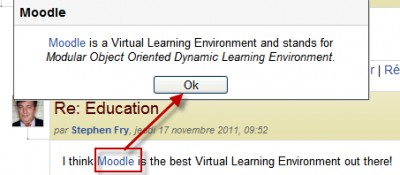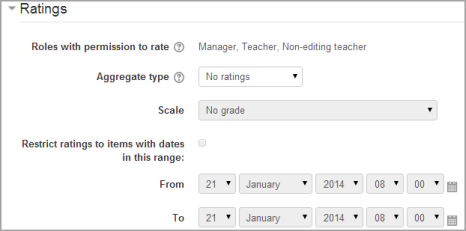Diferencia entre revisiones de «Configuraciones del glosario»
(→Añadir un glosario: Versión traducida) |
|||
| Línea 3: | Línea 3: | ||
==Añadir un glosario== | ==Añadir un glosario== | ||
Para añadir un Glosario: | Para añadir un Glosario: | ||
Mientras este activa la edición, en la sección del curso donde desea añadir el glosario, | #Mientras este activa la edición, en la sección del curso donde desea añadir el glosario, un clic en el botón "Añadir una actividad o recurso" (o, en su caso, "Añadir una actividad") permite seleccionar del menú la opción ''Glosario''. | ||
#En la siguiente página se mostrará el formulario para su configuración.<br>En el margen superior derecho se encuentra la opción "Expandir todo" para mostrar todas las opciones de configuración. | |||
==General== | ==General== | ||
| Línea 11: | Línea 12: | ||
|} | |} | ||
===Nombre=== | ===Nombre=== | ||
Permite asignarle al nuevo ''glosario'' un nombre descriptivo. | |||
===Descripción=== | ===Descripción=== | ||
Describe the purpose of the glossary and provide instructions or background information, links etc. Click the icon top left to expand the toolbars, and drag the bottom right of the text box out to expand it. | Describe the purpose of the glossary and provide instructions or background information, links etc. Click the icon top left to expand the toolbars, and drag the bottom right of the text box out to expand it. | ||
Revisión del 20:58 26 feb 2019
Nota: Pendiente de Traducir. ¡Anímese a traducir esta página!. ( y otras páginas pendientes)
Añadir un glosario
Para añadir un Glosario:
- Mientras este activa la edición, en la sección del curso donde desea añadir el glosario, un clic en el botón "Añadir una actividad o recurso" (o, en su caso, "Añadir una actividad") permite seleccionar del menú la opción Glosario.
- En la siguiente página se mostrará el formulario para su configuración.
En el margen superior derecho se encuentra la opción "Expandir todo" para mostrar todas las opciones de configuración.
General
Nombre
Permite asignarle al nuevo glosario un nombre descriptivo.
Descripción
Describe the purpose of the glossary and provide instructions or background information, links etc. Click the icon top left to expand the toolbars, and drag the bottom right of the text box out to expand it.
Mostrar descripción en la página del curso
If this box is ticked, the description will appear on the course page just below the name of the glossary.
¿Es global éste glosario?
Administrators can make a global glossary, with entries linking throughout the whole Moodle site. Any course may contain a global glossary, though the best practice is to place a global glossary on the site front page.
Tipo de glosario
Here you can decide whether the glossary will be main or secondary. The glossary system allows you to export entries from any secondary glossary to the main one of the course. In order to do this, you should specify which glossary is the main one. You can only have one main glossary per course.
Entradas
(These settings are collapsed by default)
Aprobadas por defecto
If set to "yes" then new entries appear automatically. If not, then the teacher must approve each one first.
Siempre permitir edición
If set to "yes", students can edit their entries at any time. If not, then they can only edit for a certain period (as defined in Políticas del sitio).
Permitir entradas duplicadas
This allows the entry of more than one definition for a given word.
Permitir comentarios en las entradas
Students and teachers can leave comments on glossary definitions. The comments are available through a link at the bottom of the definition.
Enlazar automáticamente entradas al glosario
If the Filtro de auto-enlace a glosario is enabled by an administrator (see Filtros for further details), then turning this on allows individual entries in this glossary to be automatically linked whenever the concept words and phrases appear throughout the rest of the same course. This includes forum postings, internal resources, week summaries and so on.
Note: Enabling linking for the glossary does not automatically turn on linking for each entry - linking needs to be set for each entry individually. If you do not want particular text to be linked (in a forum posting, say) then you should add <nolink> and </nolink> tags around the text. Note that category names are also linked.
Apariencia
(These settings are collapsed by default)
Formato para visualizar
That specifies the way that each entry will be shown within the glossary. The default formats are:
- Simple, dictionary style - This looks like a conventional dictionary with separate entries. No authors are displayed and attachments are shown as links.
- Continuous without author - Like the simple style. Shows the entries one after other without any kind of separation but the editing icons, but only if your theme supports it, you usually have to modify the theme if you want an alternative appearance to the simple setting.
- Full with author - A forum-like display format showing author's data. Attachments are shown as links.
- Full without author - A forum-like display format that does not show author's data. Attachments are shown as links.
- Encyclopedia - Like 'Full with author' but attached images are shown inline.
- Entry list - This lists the concepts as links.
- FAQ - Useful for displaying lists of frequently asked questions. It automatically appends the words QUESTION and ANSWER in the concept and definition respectively.
| Format | Entry | Author | Date | Definition | Images | Attachments |
|---|---|---|---|---|---|---|
| Entry list | x | - | - | x | x | link |
| Simple Dictionary | x | - | - | x | x | link |
| Continuous | x | - | - | x | x | link |
| FAQ | x | - | x | x | x | link |
| Full without Author | x | - | x | x | x | link |
| Full with Author | x | x | x | x | x | link |
| Encyclopedia | x | x | x | x | x | x* |
* Attached images are shown inline.
Formato para mostrar aprobación
It is possible to set an alternative display format for when entries are approved that can differ from the display format on the course page. This could be useful for instance if a tutor wants to see who made a particular glossary entry before approving it but doesn't want the students' name to be displayed for others on the course page.
Entradas mostradas por página
Enter the number of entries to show to the user looking at the glossary activity. For example, the teacher may want to display one definition at a time to a student. The default is 10 entries.
Mostrar enlaces alfabéticos
If set to "yes", users can browse the glossary by letters of the alphabet.
Mostrar enlace a 'TODO'
If set to "yes", users can browse all the entries at once
Mostrar enlace a 'Especial'
If set to "yes", users can can browse the glossary by special characters, such as @ and #.
Permitir vista para impresión
This provides a printer-friendly version link for students. (Teachers are always provided with a printer-friendly version link.)
Calificación aprobatoria
Here you can set a passing grade for the glossary. This may be connected with Finalización de actividad and Actividades condicionales such that a student will not be able to access a follow up activity until they have obtained the required rating in this glossary.
RSS
(These settings are collapsed by default and only visible if RSS has been enabled on the site and for the glossary.)
RSS feed for this activity
This turns RSS on or off. When set to “None,” the RSS feed is disabled. When set to “Concepts with authors,” the RSS feed will send out the glossary entries with the name of the author. When set to “Concepts without authors,” the RSS feed sends out glossary entries without the name of the author.
Number of RSS recent articles
This number sets the number of entries that go out via RSS. If this number is set to 5, then the 5 most recent articles will be sent to subscribers. As new entries get added, the oldest entry gets replaced on the RSS feed. If your glossary gets a lot of posts every day, you will want to set this number high.
When RSS is enabled for your glossary, an orange RSS button appears on the main page (in the upper right-hand side). When a user clicks on the RSS button, they see the XML code displayed, needed by the news-reader. Once a user has the RSS news-feed link, adding it to a reader is simple and will then display Glossary aggregated information, along with other information they subscribe to.
Calificación
(This setting is collapsed by default) Choose the category in which this glossary will appear if ratings are enabled.
Valoraciones
(This setting is collapsed by default)
Roles con permisos para valorar
Glossary entries can be rated using a escala. By default, only teachers can rate glossary entries, though students can be given permission to do so if desired from Administration>Glossary administration. This is a useful tool for giving students participation grades. Any ratings given are recorded in the Libro de calificaciones.
Permisos del glosario
Role permissions for the activity can be changed in Course administration > Glossary administration > Permissions.
Configuraciones de la administración del sitio
Default settings for a glossary activity and for adding a new entry can be set by an administrator in Site administration > Plugins > Activity modules > Glossary.
If desired, the number of possible display formats may be reduced by clicking on the eye next to the format to disable it.
Display formats may be edited to specify various defaults, such as the sort order.
¡Nueva característica
en Moodle 3.0!
A partir de Moodle 3.0, pueden especificarse pestañas visibles para cada formato para visualización, de forma tal que los formatos de visualización sin autor no tiene una pestaña para 'Ojear por autor'.
Vea también
- Moodle 2 Glossary MoodleBites video on YouTube






